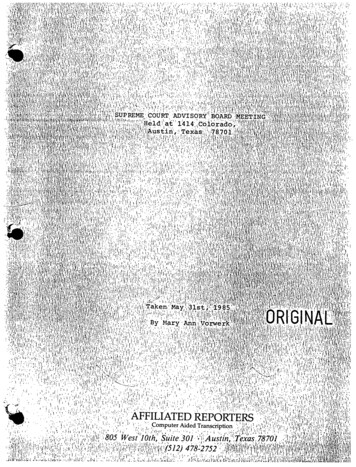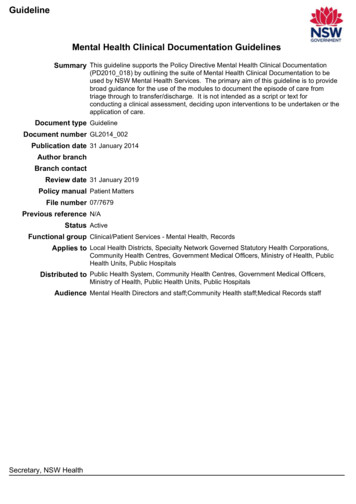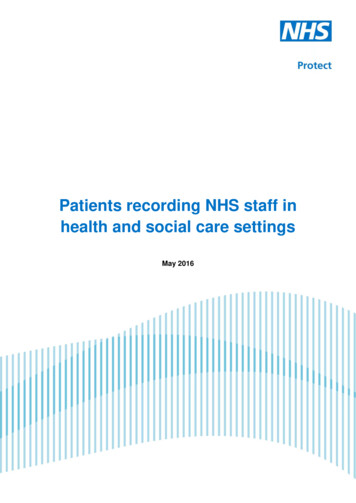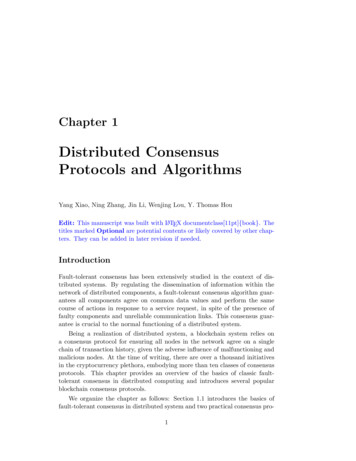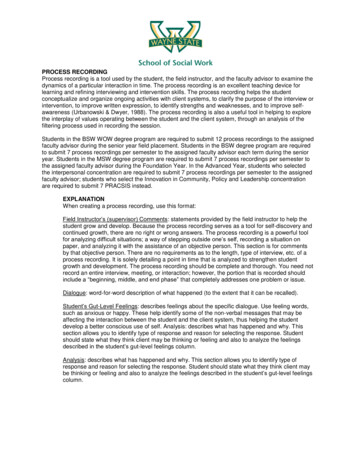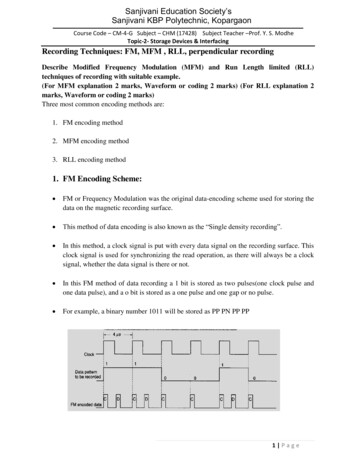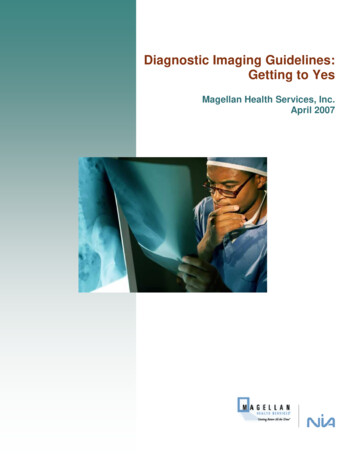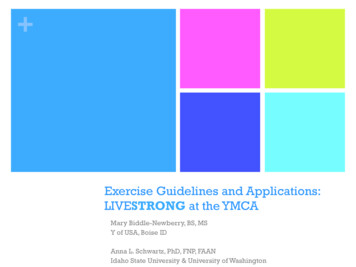
Transcription
Clinical Guidelines by ConsensusRecording a Standard 12-Lead ElectrocardiogramAn approved method by theSociety for Cardiological Science & Technology(SCST)Issue Date: September 2017Review Date: September 2022
Clinical Guidelines by ConsensusRecording a standard 12-lead electrocardiogramAn approved method by the Society for CardiologicalScience & Technology (SCST)Document IDLead Author(s)Lead Authors’ job titlesCS 3Brian Campbell, David Richley,Catherine Ross, Christopher EggettSee acknowledgementsDocument version numberRatifying committeeRatification dateCS 3.1SCST CouncilSeptember 2017Review dateBody responsible for reviewCommittee for reviewSeptember 2022SCST CouncilStandards CommitteeContact for documentReferencing IncludedKey Words (for searching)www.scst.org.ukYesECG, electrocardiogram, 12-leadIntended usersPractitioners recording 12-lead ECGEquality Impact AssessmentYesPlease cite as:Campbell B, Richley D, Ross C, Eggett CJ. Clinical Guidelines by Consensus:Recording a standard 12-lead electrocardiogram. An approved method by theSociety for Cardiological Science and Technology (SCST) 2017.Available at:http://www.scst.org.uk/resources/SCST ECG Recording Guidelines 2017(include date accessed)CS3: Recording a 12-lead ECGPage 2
AcknowledgementsLead authors:Brian Campbell, SCST Chair of StandardsClinical ScientistHead of Training in Echocardiography/Cardiac Outpatients ManagerGuy’s & St Thomas’s NHS TrustDave Richley, SCST Vice PresidentRetired Cardiac PhysiologistAssociate Lecturer, Newcastle UniversityAcademic Tutor, Sunderland UniversityCatherine Ross, SCST PresidentClinical ScientistClinical Leadership Lead at the Office of the Chief Scientific OfficerNHS EnglandChristopher Eggett, SCST Education Committee MemberSenior Lecturer & Deputy Dean – Post graduate taught programmesNewcastle UniversityWith many thanks to the following people for help in thedocument review process:Joanne Ashton, SCST TreasurerClinical ScientistTracy Simpson, SCST Council memberCS3: Recording a 12-lead ECGPage 3
Contents1.CHANGE HISTORY . 52.INTRODUCTION . 53.PURPOSE. 64.PATIENT EXPERIENCE, PRIVACY AND DIGNITY . 64.14.24.34.45.PATIENT PREPARATION . 85.15.26.PATIENT POSITION . 8SKIN PREPARATION . 8ELECTRODE PLACEMENT . 96.16.26.37.PATIENT IDENTIFICATION . 6COMMUNICATION AND INFORMED CONSENT . 7CHAPERONE . 7LEVEL OF UNDRESS . 7LIMB ELECTRODE POSITIONS. 9PRECORDIAL (CHEST) ELECTRODE POSITIONS . 10TECHNIQUE FOR LOCATING CHEST ELECTRODE POSITIONS . 11OBTAINING A GOOD QUALITY RECORDING .127.1VARIATION FROM STANDARD . 138.QUALIFICATION AND TRAINING OF STAFF RECORDING 12-LEAD ECGS .139.EQUIPMENT AND CLINICAL ROOM SPECIFICATION .139.19.29.3EQUIPMENT SPECIFICATION . 14ENVIRONMENTAL CONSIDERATIONS . 14INFECTION CONTROL. 1510. DOCUMENTATION, PROCESSING, STORAGE AND CONFIDENTIALITY OF ECGRECORDINGS .1511. AUDIT.1612. SPECIAL SITUATIONS.1612.112.212.3DEXTROCARDIA . 16POSTERIOR ELECTRODE POSITIONS . 17ELECTROCARDIOGRAPHY ON CHILDREN . 1813. CONCLUSION .1814. REFERENCES.1915. APPENDIX 1: 12-LEAD ECG SERVICE AUDIT TOOL .2316. ECG STANDARD ELECTRODE POSITIONS REMINDER CHART .2417. ECG SETTINGS REMINDER CHART .25CS3: Recording a 12-lead ECGPage 4
1.2.Change historyVersion DateAuthor1Feb 2010Consensus2June 2014Consensus2.1Nov 2015Consensus3Sept tion of Yes: SCSTpracticeCouncilStandardisation of Yes: SCSTpracticeCouncilCitationadded, Not requiredcontributor detailsupdatedStandardisation of Yes: SCSTpracticeCouncilIntroductionThe resting 12-lead electrocardiogram (ECG) is an important first lineinvestigation that records the electrical activity of the heart. This investigationcan aid the diagnosis and help define the appropriate patient treatment pathwayin a range of cardiac conditions, many of which are life threatening and requireimmediate action.Modern ECG machines are portable, low cost and easy to use and thesefeatures facilitates recordings in a wide variety of environments includinghospitals, GP surgeries, ambulances, sports facilities and patients’ homes. Thechallenge is to ensure high-quality, consistent recording techniques aremaintained irrespective of the clinical scenario. ECGs not performed toappropriate standards can result in incorrect diagnoses and inappropriatetreatments1-7. There are many personnel recording ECGs who have not beenproperly trained or assessed8.Personnel may consider themselves9,10competent, despite a lack of training, and yet lack essential knowledge inECG recording technique that results in incorrect ECG recording11-14.Evidence indicates that appropriate training leads to fewer ECG recordingerrors15.While these guidelines generally apply to the hospital/clinicalenvironment, where most ECGs are performed, the training of personnel andtechnical aspects of the performance of a standard ECG apply to all situations.SCST recommends that all personnel who record ECGs are appropriatelytrained, assessed and qualified.These guidelines provide essential information pertinent to the correct ECGrecording technique in keeping with good scientific practice16. They are writtenby expert practitioners following critical evaluation of published evidence.Where evidence was limited a consensus decision was made.CS3: Recording a 12-lead ECGPage 5
3.PurposeIn promoting excellence in the recording of 12-lead ECGs, these guidelinesaddress the following areas: 4.Patient experience, privacy and dignityo Patient identificationo Communication & Informed consento Chaperoneo Level of undressPatient preparationo Patient positiono Skin preparationElectrode placement:o Limb electrode positionso Chest electrode positionso Technique for locating chest electrode positionsObtaining a good quality recordingo Paper speedo Use of the filtero Variation from standard Amplitude gainQualification requirements for practitionersEquipment and clinical room specificationo Equipmento Environmento Infection controlDocumentation, processing, storage and confidentiality of 12-lead ECGrecordingsSpecial situationsPatient experience, privacy and dignityIt is vital that patient experience is placed at the centre of the process and toensure that the patient’s perception of the process is positive16.4.1Patient IdentificationIt is essential that the patient undergoing the procedure is correctly identified.For patients unable to provide their own identifying details confirmation ofidentity must be sought from carers or by using hospital wristbands.The printed recording must always be checked to ensure it bears the correctpatient details. Practitioners must be aware of potential sources of error ifdetails are not entered digitally for every patient e.g. some machines retain theCS3: Recording a 12-lead ECGPage 6
information from the last patient and these may be incorrectly printed on theECG if they have not been altered. Local policy and practice should bedeveloped to ensure that errors do not occur in busy clinical environments. Itis recommended that at least two unique patient identifiers are confirmed e.g.date of birth and address.4.2Communication and informed consentThe patient should be given clear, precise information in a format that isconsistent with their needs and level of understanding. Information can be inthe form of a booklet, information letter or oral explanation or a combination.As a minimum, SCST recommends the person performing the procedureshould introduce themselves, explain their role and provide a brief overview ofthe procedure. If possible, this should include the level of undress involved andthe use of adhesive electrodes, with a reassurance that the procedure is briefand painless. Informed consent is required in accordance with local policybefore proceeding.4.3ChaperoneIn accordance with good clinical practice, patients undergoing examinationsthat have the potential to be embarrassing or distressing should have the optionof having a chaperone present17. The chaperone should usually be a healthprofessional and must have knowledge of the standard practice of recording a12-lead ECG. Patients may also request a relative or carer to be present. Ifthe practitioner or the patient declines an examination without a chaperonepresent, or if either is uncomfortable with the choice of chaperone, an offer maybe made to defer the examination to a later date when a suitable chaperonewould be available, if the delay would not adversely affect the patient’s health17.4.4Level of undressPractitioners should respect the cultural sensitivities of the patient and minimiseembarrassment18. Patients may feel uncomfortable being touched on theirupper torso; practitioners must act in a sympathetic, caring and compassionatemanner.Patients should be asked to remove all clothing impeding access to the correctchest electrode positions. Normally this will involve undressing above the waist.Patients should be allowed to undress in a private environment with minimalrisk of interruption. Once the cables have been attached to the electrodes thepatient should be covered to preserve his/her modesty. The practitioner shouldmake every effort to ensure the patient is comfortable and relaxed to minimiseartefact on the ECG recording. Clinical discussions with the patient should onlytake place after re-dressing.CS3: Recording a 12-lead ECGPage 7
5.Patient preparationWhilst it is recognised that 12-lead ECGs are performed in a variety of contexts,environments and states of urgency, attempts to achieve best practice andstandard electrode positioning should always be made.5.1Patient positionMany patients are uncomfortable lying flat, so for consistency and practicality,a semi-recumbent position of approximately 45 degrees is recommended. Anysignificant variation from this position should be documented on the ECGrecording. The limbs should be supported by the bed/couch to minimiseartefact due to muscle tension.The ECG appearance can be affected by the angle of incline of the torso at thetime of recording. An ECG recorded from a patient in a supine position mayvary significantly from one recorded with the patient in an upright position19, 20or inclined at 60 degrees or greater to the horizontal21. There is no evidencethat variation of the inclination of the patient between horizontal and 45 degreesto the horizontal has any significant effect on the ECG.Time should be taken to ensure that the patient is relaxed and comfortable. Ifthese conditions are not satisfied the ECG may record somatic musclepotentials as well as cardiac activity and will make the ECG more difficult tointerpret and potentially limit clinical value. Some patients cannot relax fullybecause of painful conditions such as arthritis, or they may have a conditionsuch as Parkinson’s disease which causes a tremor. These patients should bemade as comfortable as possible and the ECG trace annotated with anappropriate explanation if it is suboptimal quality. Before recording the ECG,checks should be made to ensure the patient’s limbs are still and appearrelaxed. If the patient has clenched fists or stiff arms or is moving his/herfingers, it will not be possible to obtain a high-quality ECG.5.2Skin preparationSkin preparation is often required to help produce an artefact-free ECG. Caremust be taken with patients who have sensitive or broken skin. There arevarious ways to minimise the skin-to-electrode impedance, for example: The skin may require cleansing. There are a variety of methods, includingwashing with mild soap and cleaning Exfoliation may be required and should be undertaken with very lightabrasion using a paper towel, gauze swab or proprietary abrasive tapedesigned for this purpose Chest hair may need to be removed to ensure adequate contact with theskin. Oral consent should be obtained from the patient and a battery-CS3: Recording a 12-lead ECGPage 8
operated razor with a single use blade or a single use razor should beemployed and disposed of in a sharps bin immediately afterwards6.Electrode placementElectrodes must be positioned in accordance with AHA recommendations 22-24.If any of the electrodes are to be sited in non-standard positions therecording must be labelled with this information to avoidmisinterpretation of altered ECG waveforms24-28.ECG cable connections are usually colour coded to aid identification. However,colour may vary depending on manufacturer. The colours detailed in thisdocument comply with European (IEC) recommendations.Note on electrode care: disposable electrodes should be checked to ensurethey are not outside the ‘use by’ date specified by the manufacturer and thatthey are in good condition. It should be verified that the core of ‘wet-gel’electrodes has not dried out. Electrodes should be kept inside the foil packagingto prevent dehydration of the gel.6.1Limb electrode positionsLimb electrodes should be placed proximal the wrists and ankles wheneverpossible. Moving the electrodes up the limbs may alter the appearance of theECG and should be avoided unless there is a significant tremor or a limb hasbeen amputated.Note: Limb electrodes must not be placed on the torso since this causessignificant alteration to wave amplitudes. This can invalidate the use of therecording for many diagnostic purposes25, 29.Limb electrode positions:Right arm limb lead (RA, red) – right forearm, proximal to wristLeft arm limb lead (LA, yellow) – left forearm, proximal to wristLeft leg limb lead (LL, green) – left lower leg, proximal to ankleRight leg limb lead (RL, black) – right lower leg, proximal to ankleCS3: Recording a 12-lead ECGPage 9
6.2Precordial (chest) electrode positionsThe correct anatomical positions for the chest electrodes have been defined22(see figure below) and must always be used unless access is not possible. Thecentre of the active area of the electrode should be aligned with the relevantanatomical landmark.Precordial (chest) electrode positions:V1, red (C1) – Fourth intercostal space at the right sternal edgeV2, yellow (C2) – Fourth intercostal space at the left sternal edgeV3, green (C3) – Midway between V2 and V4V4, brown (C4) – Fifth intercostal space in the mid-clavicular lineV5, black (C5) – Left anterior axillary line at the same horizontal level as V4V6, purple (C6) – Left mid-axillary line at the same horizontal level as V4 & V5Studies have demonstrated that the V1 and V2 electrodes are frequently placedtoo high and the V4, V5 and V6 electrodes too low13, 30, 31, 32. These errors canresult in diagnostically misleading alterations to the ECG waveform33.CS3: Recording a 12-lead ECGPage 10
6.3Technique for locating chest electrode positionsAccurate identification of the appropriate intercostal spaces should begin withlocation of the manubriosternal joint, also known as the angle of Louis. To locate the angle of Louis a finger should be run down the sternum fromthe top until a bony horizontal ridge is met. Sliding the finger down and tothe right side will locate the second intercostal space. From here it ispossible to count down to the third and fourth intercostal spaces. In thefourth space, the finger should be slid towards the sternum until the edge isfelt. This is where the centre of the V1 electrode should be placed. This procedure should be repeated on the left side to correctly position theV2 electrode. (Note that the left and right sided rib spaces may be offset,so practitioners should avoid placing V2 adjacent to V1 without counting therib spaces). Next, the V4 electrode should be placed in the 5th intercostal space in linewith the mid-point of the clavicle. The V3 electrode should then be placed mid-way between the V2 and V4electrodes. The V5 and V6 electrodes should then be positioned in horizontal alignmentwith the V4 electrode. The V5 electrode should be placed on the anterioraxillary line; the V6 electrode should be placed on the mid-axillary line.When recording an ECG from female patients it is convention to place the V4,V5 and V6 electrodes beneath the left breast when breast tissue overlies thecorrect anatomical positions. There is some evidence to suggest that thepositioning of these electrodes over the breast may not significantly attenuatethe signal33, 34 but further supporting evidence is needed to warrant a change inthis recommendation.When lifting the breast to place electrodes, care and sensitivity is required.Using the back of the hand to lift the breast can be helpful in minimising contact.To achieve accurate ECG electrode positioning, it is usually necessary for allupper torso clothing to be absent.Note: If positioning varies from the recommended positions it is essential thatthis is documented on the ECG recording, including electronically stored ECGs.CS3: Recording a 12-lead ECGPage 11
7.Obtaining a good quality recordingA 12-lead ECG and simultaneous rhythm strip is most commonly recorded at25mm/s with a gain setting of 10mm/mV. The appropriate button should bepressed to initiate a recording; this is usually labelled as ‘start’ or ‘auto’.Standard ECG recording settings:Paper speed – 25mm/secVoltage gain – 10mm/mVAll filters should be ‘off’ for the initial attempt to record an ECG. The low-passfilter will reduce interference but it also distorts the ECG35, so should only beused when necessary and only after all attempts to eliminate the interferencehave failed.If, despite efforts to relax the patient and make them comfortable, there issomatic muscle interference on the ECG, the filter may be switched on and therecording repeated. Use of the filter should be clearly identified on the finalECG.Use of the filter (in auto mode):Initial recording – filter off – recording made at 0.67 - 150HzEvidence of somatic muscle interference:Repeat recording – filter on – recording made at 0.67 - 40HzThe filter reduces interference but also distorts the ECGAny features on the ECG that might indicate the need for urgent medicalattention should be brought to the attention of appropriate staff. If the patienthas any symptoms of possible cardiac origin, such as chest pain, palpitationsor dizziness, at the time of recording, then this should be noted on the ECG.Confirmation that an ECG of good quality has been recorded should be madeby the practitioner. The recording should be assessed to ensure that allwaveforms (such as P waves, QRS complexes and T waves) are clearly visible.The isoelectric line (the baseline between ECG deflections) should be stable,not wandering, and free of interferenceAt the end of the procedure, all the electrodes should be removed from thepatient and disposed of as clinical waste.CS3: Recording a 12-lead ECGPage 12
Note: Incorrectly pressing ‘copy’ or ‘reprint’ may on some models of ECGmachine initiate a printout of an ECG from a previous patient36. If patient detailsare not entered into the machine it may not be clear that this ECG relates to aprevious patient. Practitioners must fully understand the equipment they areusing and the potential consequences of mistakes. Local practice guidancemust minimise the chance of an identity or recording error occurring in this way.7.1Variation from standardIf ECG complexes are of such high amplitude that they overlap, then the gainmay be adjusted to 5mm/mV to enable clearer visualisation of the complexesand more accurate measurements to be made. Any alteration to the gainsettings should be clearly marked on the ECG.On occasions, it may be necessary to adapt the recommended ECG recordingtechniques. For example, patients in wheelchairs may need to remain in theirwheelchair during the recording process. Any variations to standard recordingtechniques should be described clearly on the recording for hard copy andelectronically stored ECGs.8.Qualification and training of staff recording 12-lead ECGsThe practitioner must be competent in the use of the electrocardiograph and inthe recording of an ECG10. This should be demonstrated by the possession ofa recognised qualification, such as one of those awarded by the Society forCardiological Science and Technology, including: Award in Practical ElectrocardiographyCertificate in ElectrocardiographyIt is essential that competence in the recording of an electrocardiogram bemaintained and this should be demonstrated by periodic review.9.Equipment and clinical room specificationThe room and equipment should be clean and orderly with all waste fromprevious investigations disposed of in line with local policy and guidance.Equipment should be safe and ready to use with correct date and time settings.A visual inspection should be performed prior to use to ensure that mains leads,cables and connectors are intact with no evidence of fractures, faults orinsulation damage.For battery-operated machines, the battery will need to have sufficient charge.It may be useful for a mains-powered ECG machine to have an easilyCS3: Recording a 12-lead ECGPage 13
distinguishable plug if it is to be used in environments where several items ofvital equipment are plugged into wall sockets e.g. intensive care units.9.1Equipment specificationThe electrocardiograph must meet or exceed the requirements of InternationalElectrotechnical Commission standards IEC 60601-2-25:2015 whichestablishes requirements for safety, including essential performance ofrecording and analysing single channel and multichannel electrocardiographs.The device should be pre-programmed in accordance with the American HeartAssociation (AHA) specifications22 as follows: To avoid distortion of the ST segment the low-frequency cut-off should beno higher than 0.67Hz in ‘auto’ mode or 0.05Hz in ‘manual’ mode.Note: Digital filter design allows for a low-frequency filter level of 0.67Hz whenrecording in ‘auto’ mode. However, this may cause ST segment distortion whenthis setting is used in ‘manual’ mode. Fixing the low frequency setting at 0.05Hzin the pre-set should prevent this error occurring. To prevent the loss of high frequency information the high frequency cut-offshould be no lower than 150Hz in adults and adolescents and no lower than250Hz in children Disposable tab electrodes must meet or exceed the requirements of theAmerican National Standards Institute/Association for the Advancement ofMedical Instrumentation (ANSI/AAMI) EC12:2000(R)2015, whichestablishes minimum labelling, safety and performance requirements fordisposable electrodes used for diagnostic electrocardiographyRecommended recording bandwidths pre-stored in ECG device setup:‘Auto’ mode0.67 – 150Hz‘Manual’ mode0.05 – 150HzMains filter9.2offEnvironmental considerationsThe environment in which a 12-lead ECG is recorded may contributeconsiderably to the quality of the patient experience and output. As far aspossible the environment should be:CS3: Recording a 12-lead ECGPage 14
9.3SafePrivate: walled, curtained or screenedQuietComfortableAccessible for disabled and able-bodied patients and staffFurnished with a height adjustable couch accessible from both sidesStocked appropriately, with battery operated razor with a single use blade(or a single use razor), electrodes, ECG paper, etc.Clean, with appropriate hand-cleaning and clinical waste facilitiesInfection controlAppropriate measures to minimise the risk of infection transmission must beundertaken in accordance with local policy.Hands should be washed37 with soap and water or cleansed with alcohol gel,as per local policy, before and after any contact with a patient. It may bereassuring to patients if this is done in their presence.For patients requiring high levels of infection control precautions, personalprotective equipment such as gowns and gloves must be worn in accordancewith local policies.Appropriate clinical waste disposal facilities should be available includingsharps bins for the disposal of the single-use blade for a battery-operated razoror a single use eandconfidentialityofECGThe ECG should be correctly labelled with the patient’s identification, relevantclinical details and any variations to the normal recording conditions. ECGrecordings that are digitally stored should be accompanied by the followingidentifiers to ensure accurate retrieval of clinical data and allow audit: Patient’s first name and surname (formatted and spelled correctly)Patient’s date of birthA unique identifying number if availableThe name and position of the referrerIdentity of the person making the recording of the ECGDate and time of the recordingThe name of the institutionAlterations from standard lead positions must be noted (section 8.1)CS3: Recording a 12-lead ECGPage 15
Typically, the electronic storage of ECG recordings is made by compressingdata. This can speed up the transmission and retrieval of records that arestored in central databases and minimise the memory required for storage.Data compression affects high frequency (short duration) signals more than thesmoother low frequency (longer duration) signals. Therefore, compression hasgreater potential to alter measurements within the QRS complex, such aspacemaker ‘spikes’, Q-wave duration and R-wave amplitude, than to alter othersignals such as the ST segment and the T-wave. A non-compressed ECG maydiffer from its compressed version. This has the potential to affect thecomparison of serial ECGs when retrieving ECGs from storage media.For the electronic storage of ECGs, it is recommended that compressionalgorithms should perform in a manner that allows retrieved data to adhere tothe fidelity standards established in the 1990 AHA statement with reference tothe original signal38.All information pertaining to the patient should be treated in a confidentialmanner in accordance with local policies and national guidelines on dataprotection39.11.AuditAudit is a recognised way of assessing and improving practice. The appendix40contains a useful checklist intended for use and an audit tool. This checklistcan be used to assess how well the guideline is being followed. It may also beused to ensure that any local guidelines developed from this consensusdocument meet the requirements for competent service delivery.12.Special
Before recording the ECG, checks should be made to ensure the patient’s limbs are still and appear relaxed. If the patient has clenched fists or stiff arms or is moving his/her fingers, it will not be possible to obtain a high-quality ECG. 5.2 Skin preparation Skin preparation is often required to
